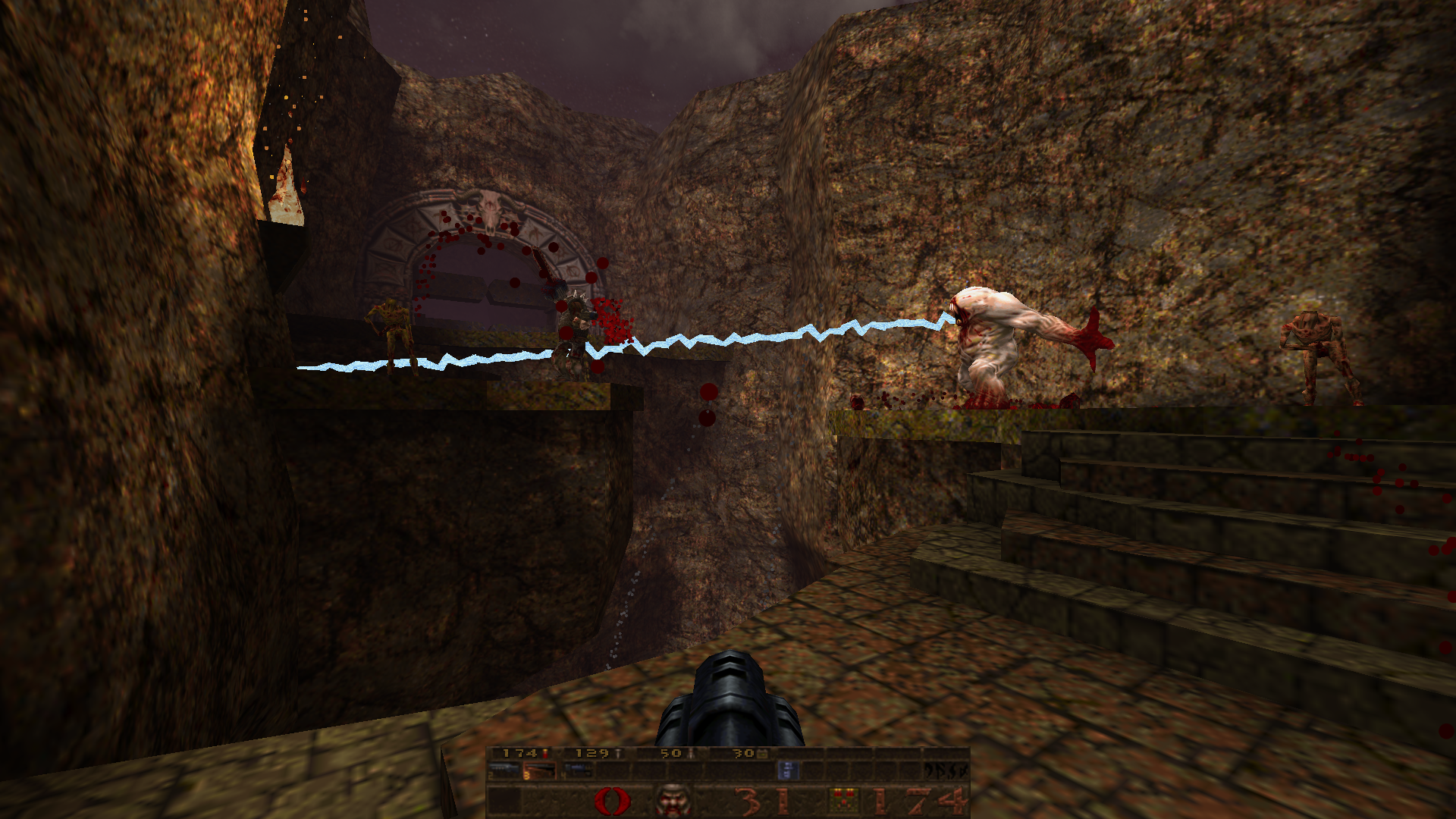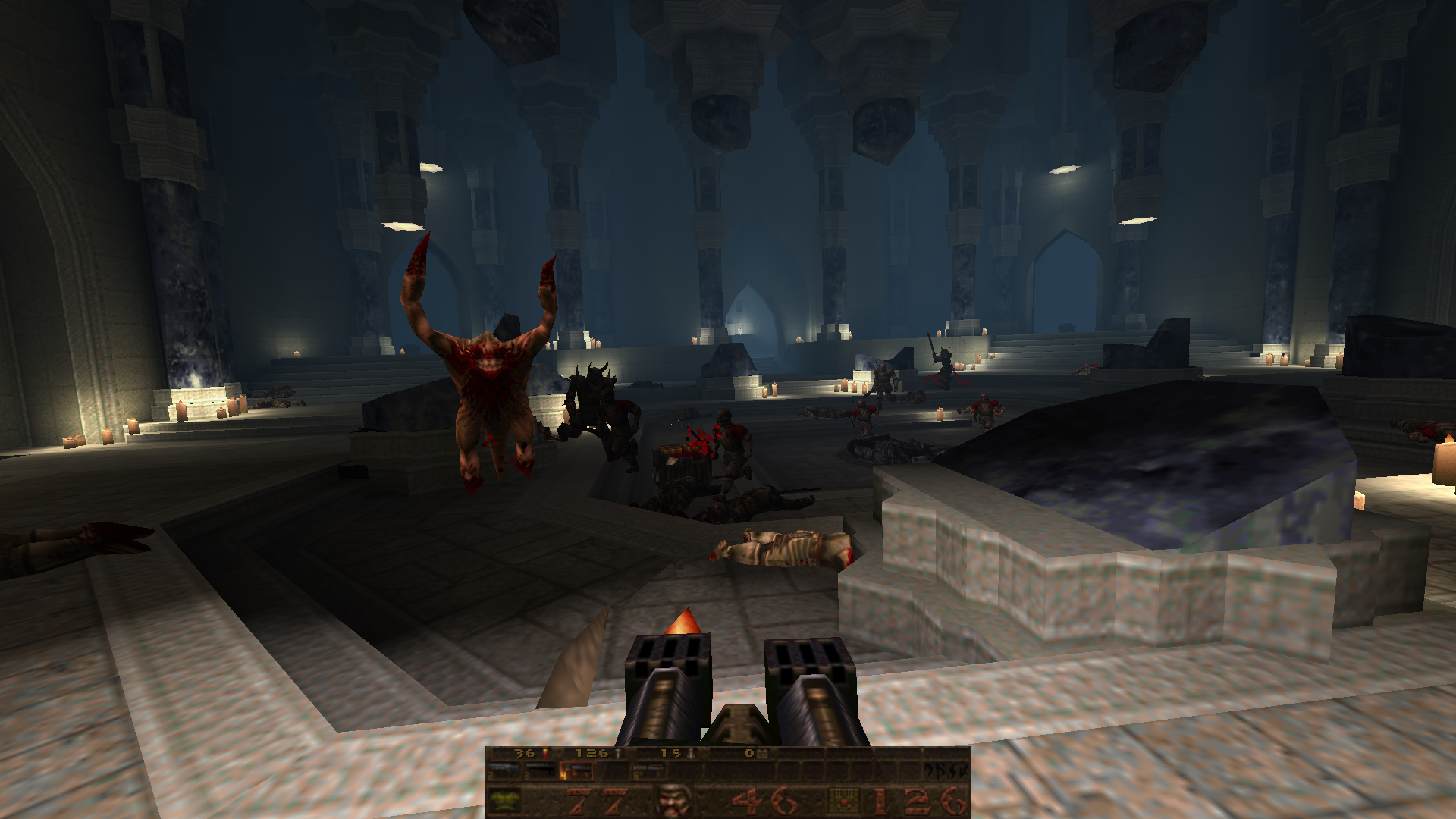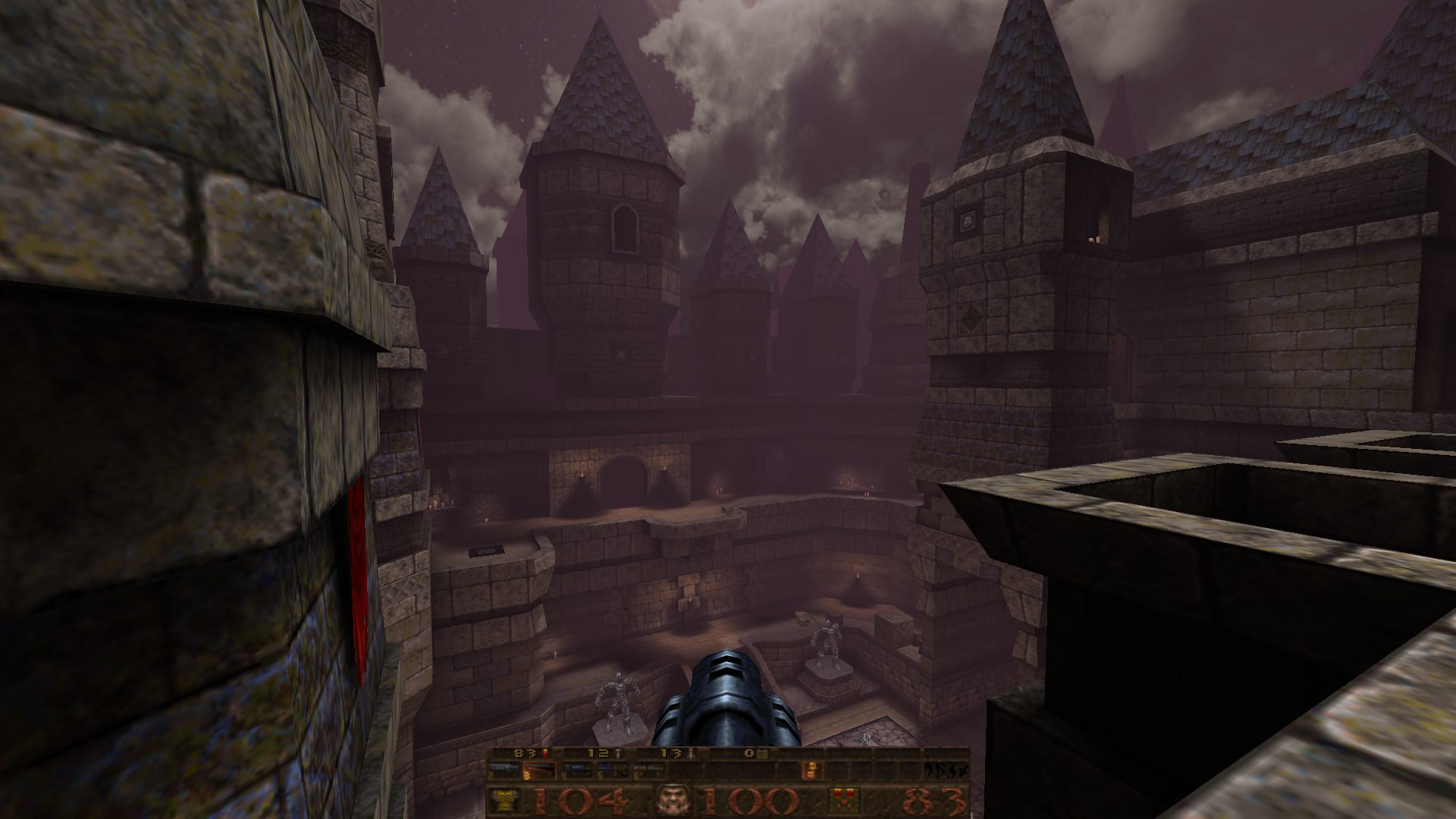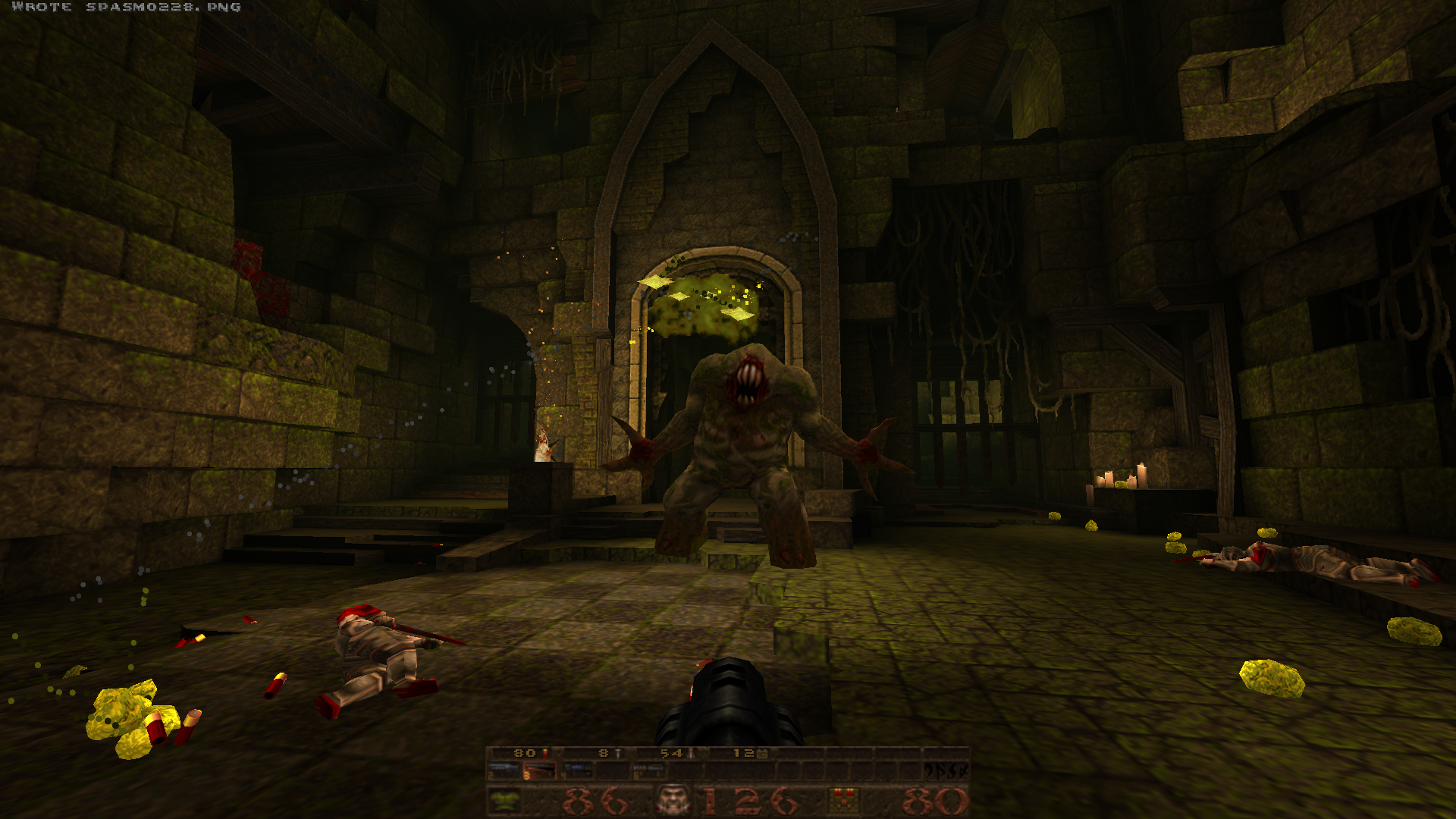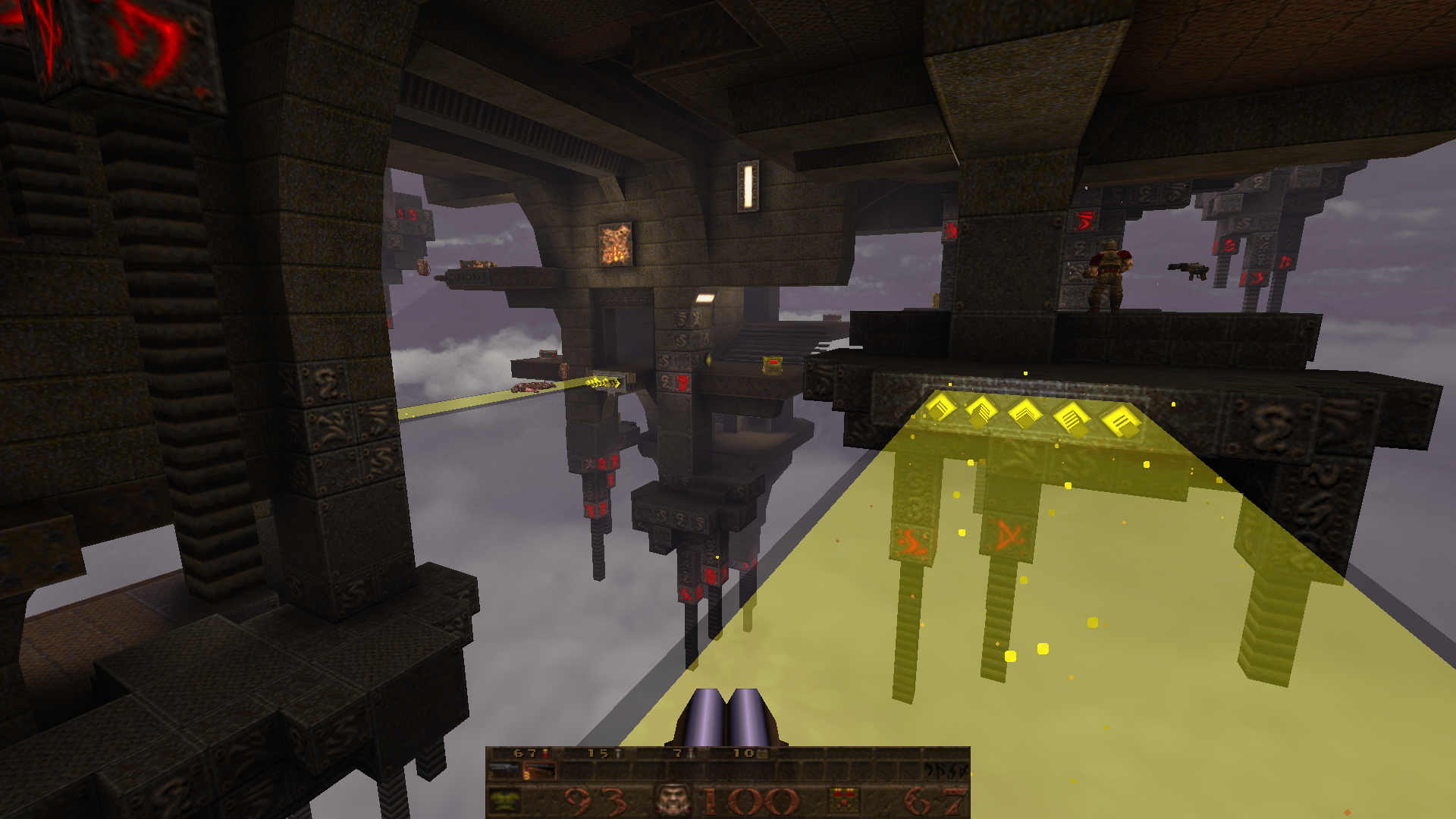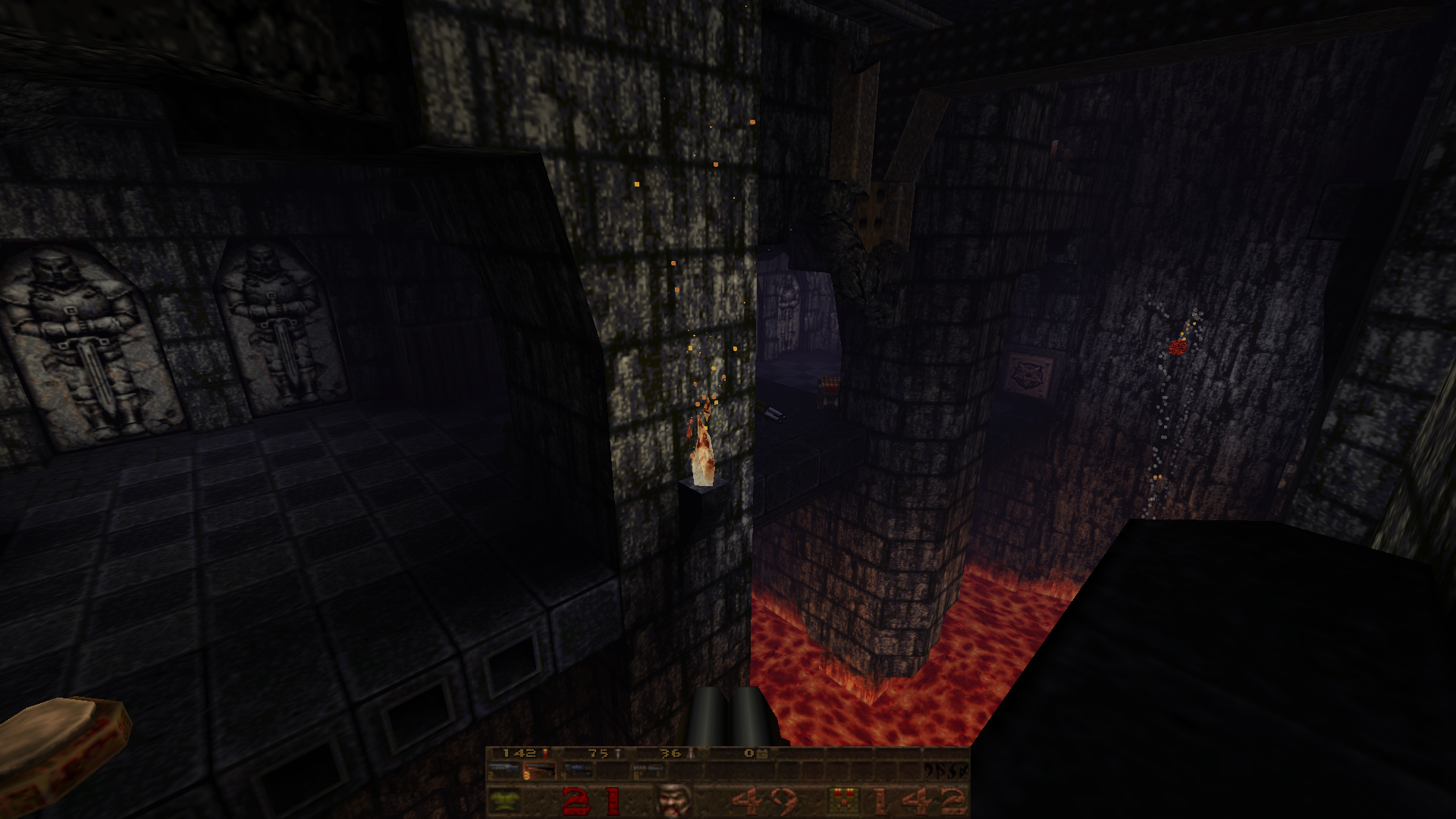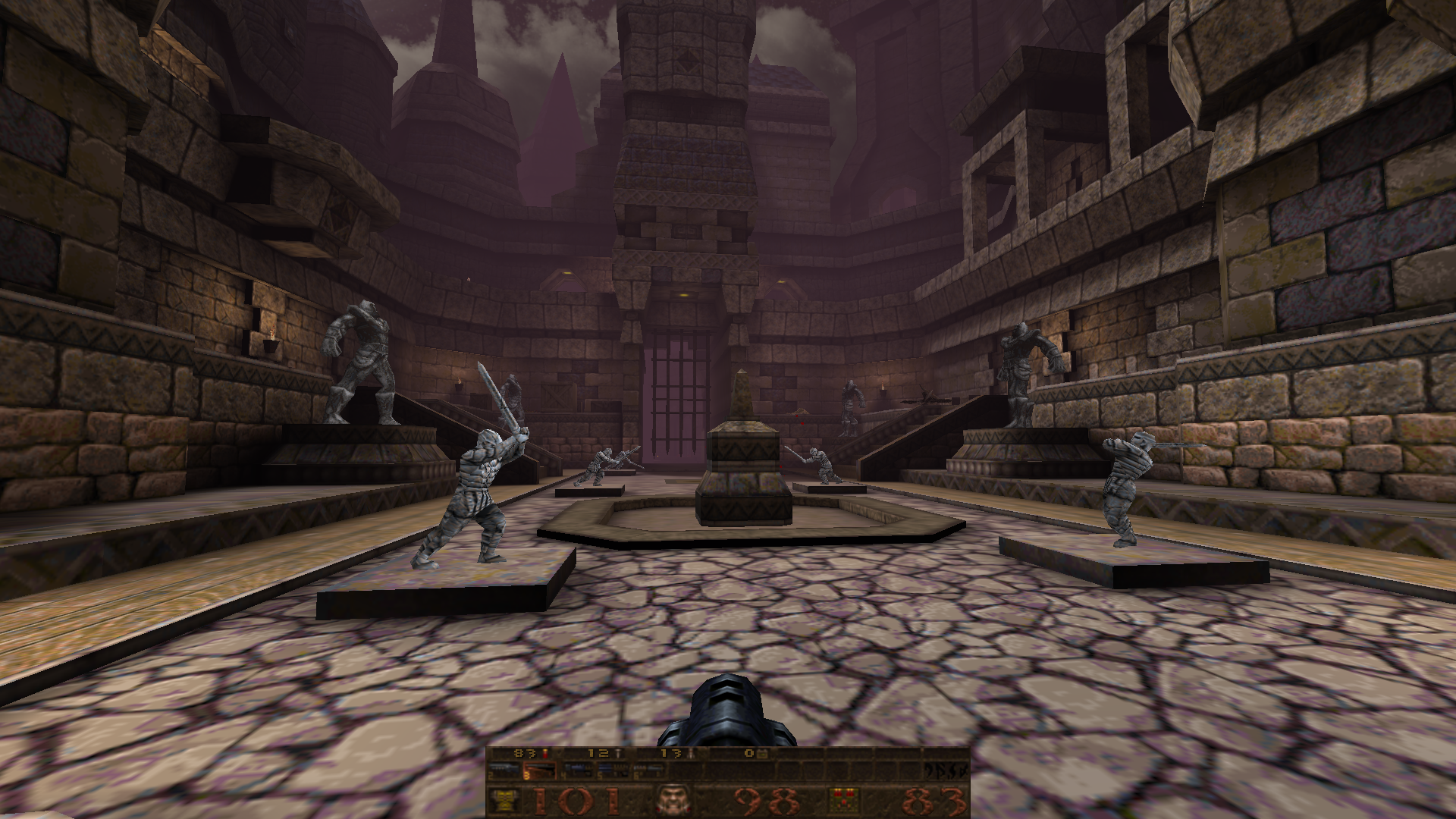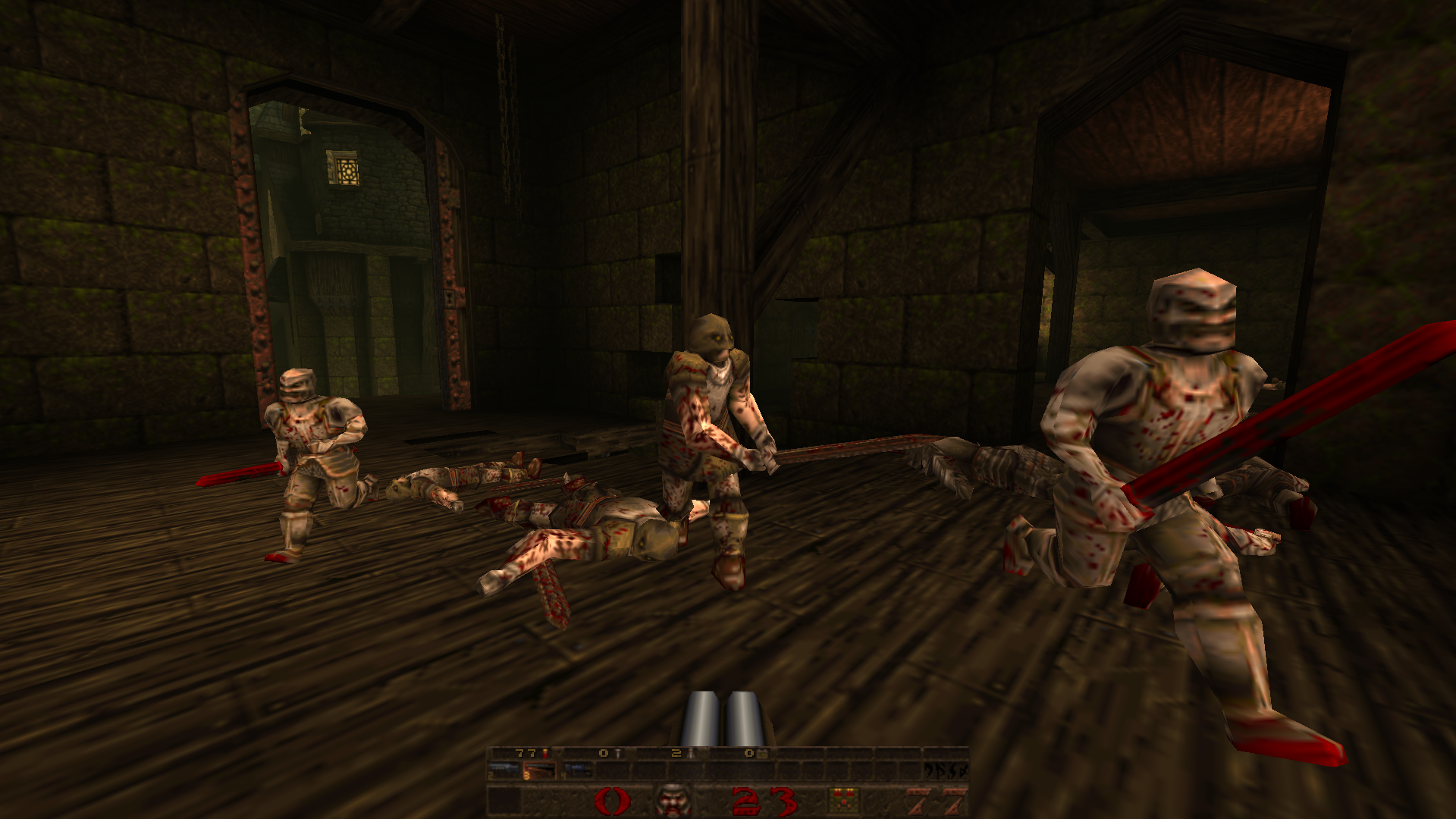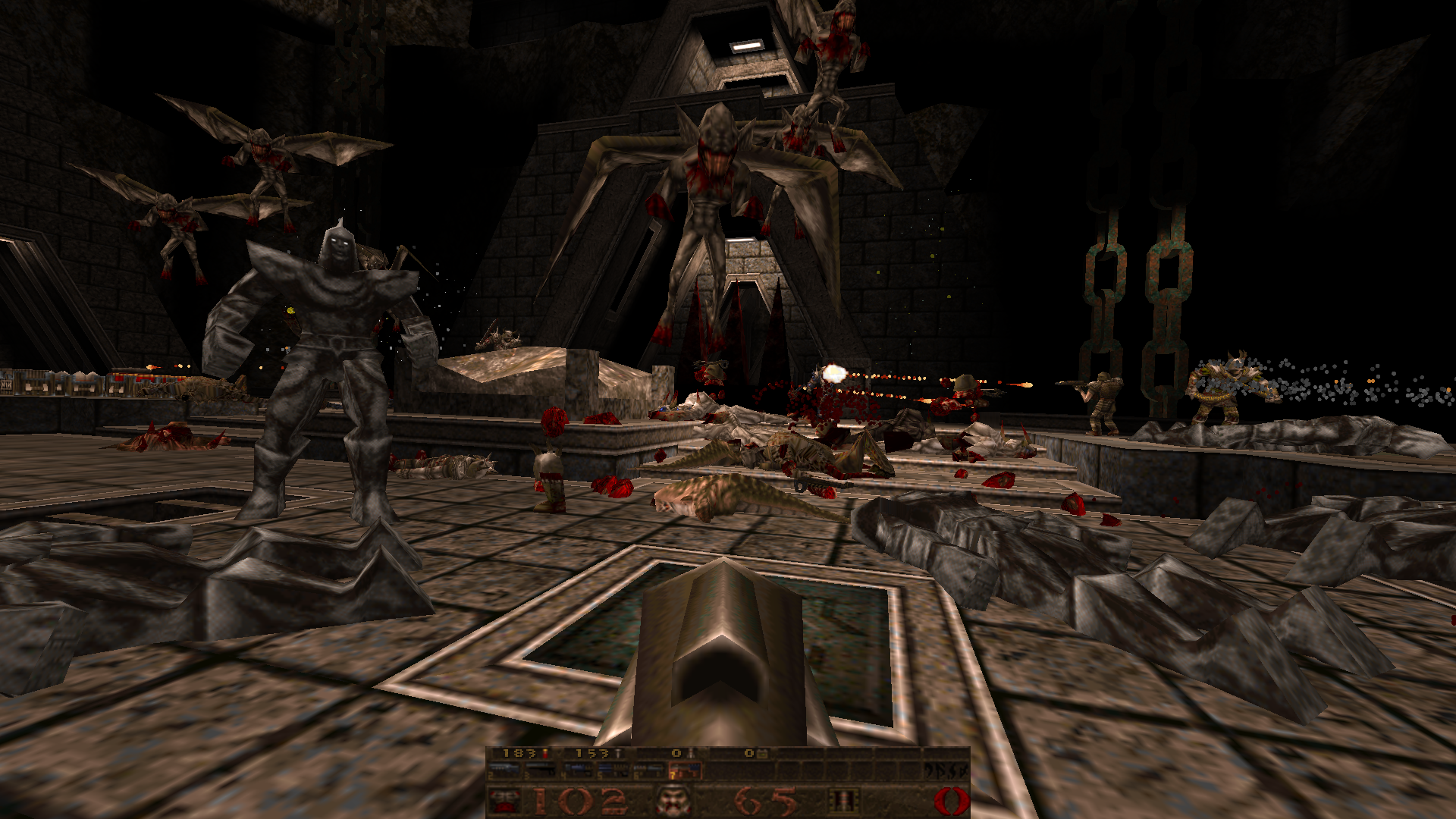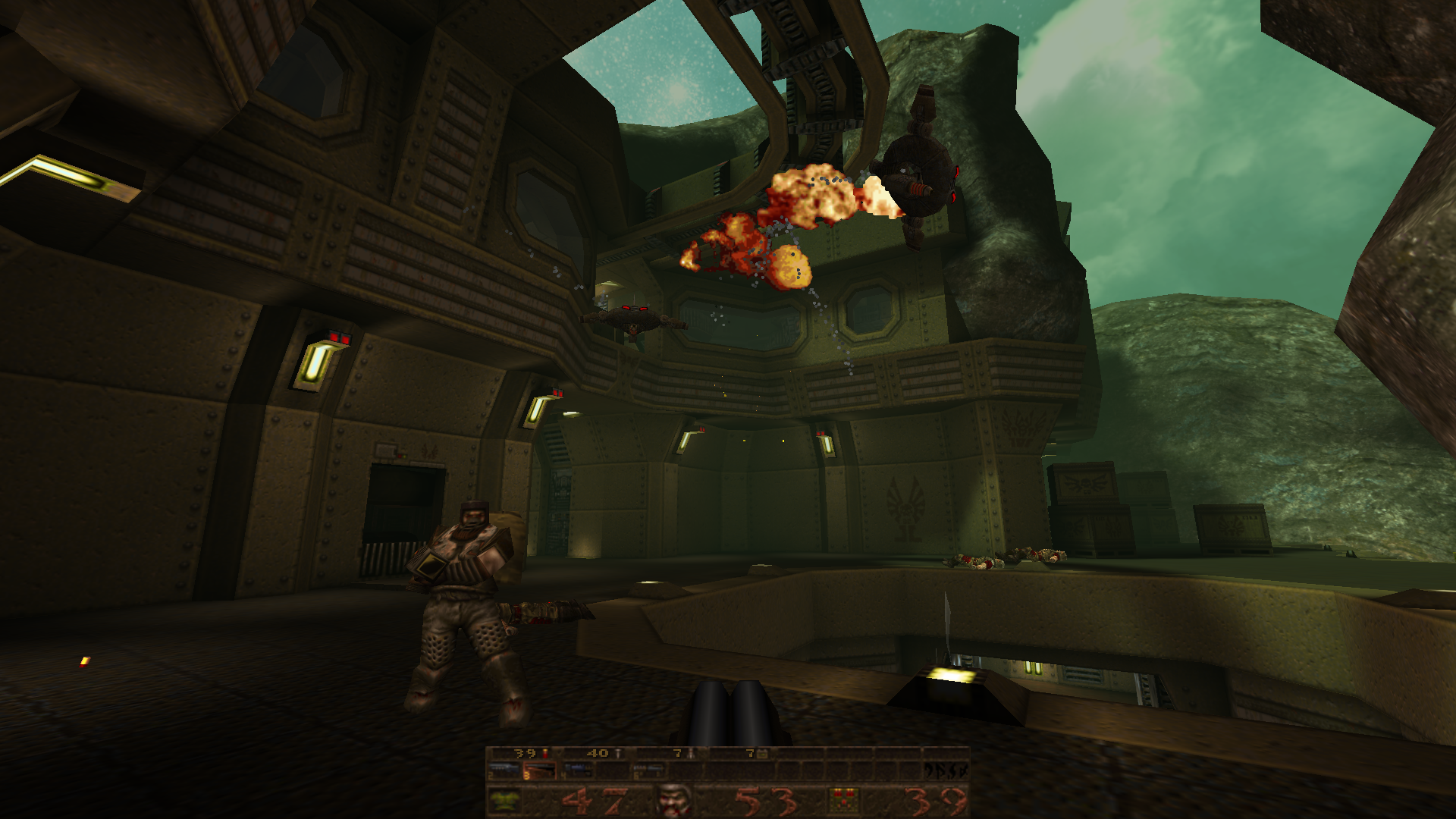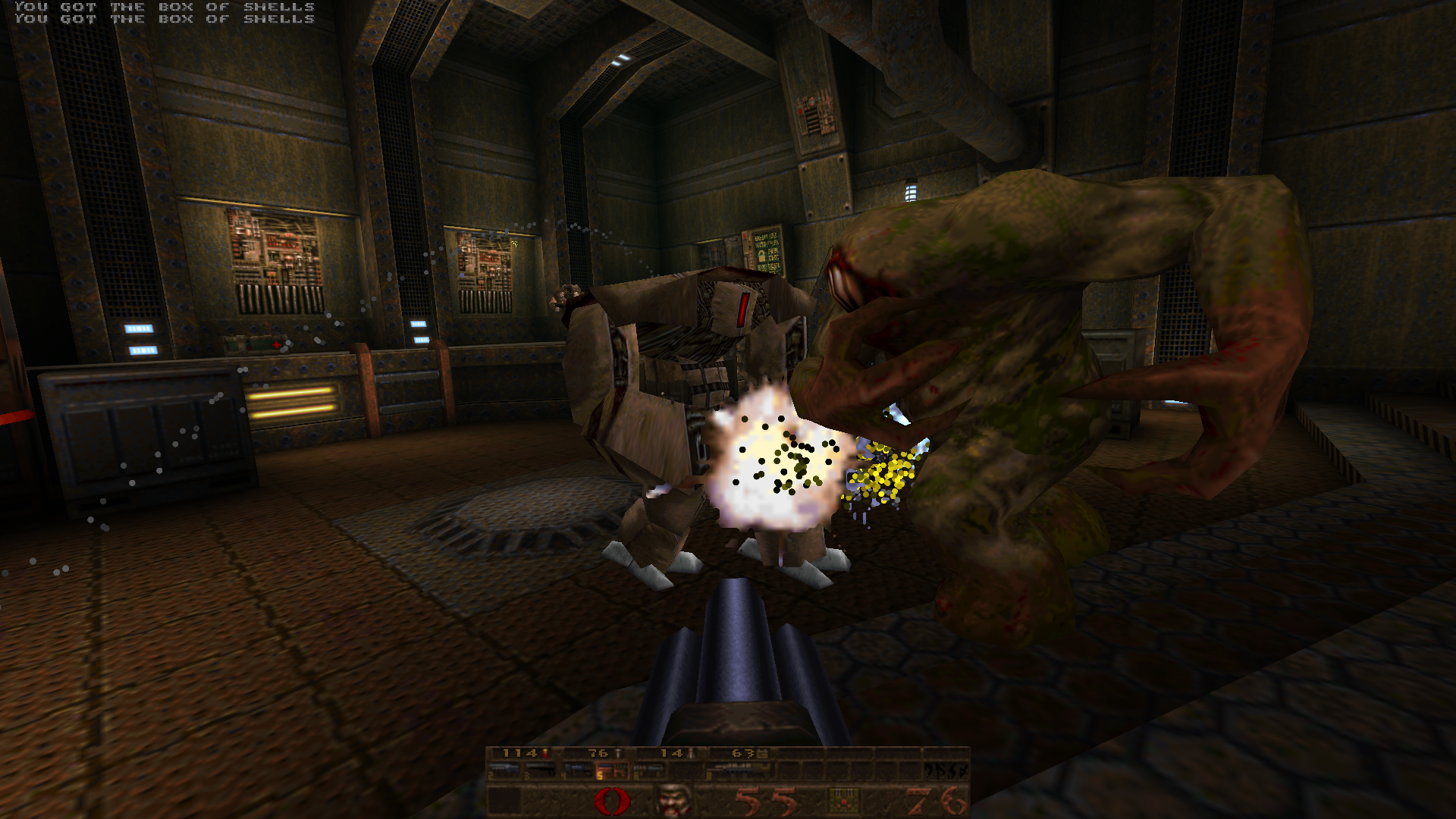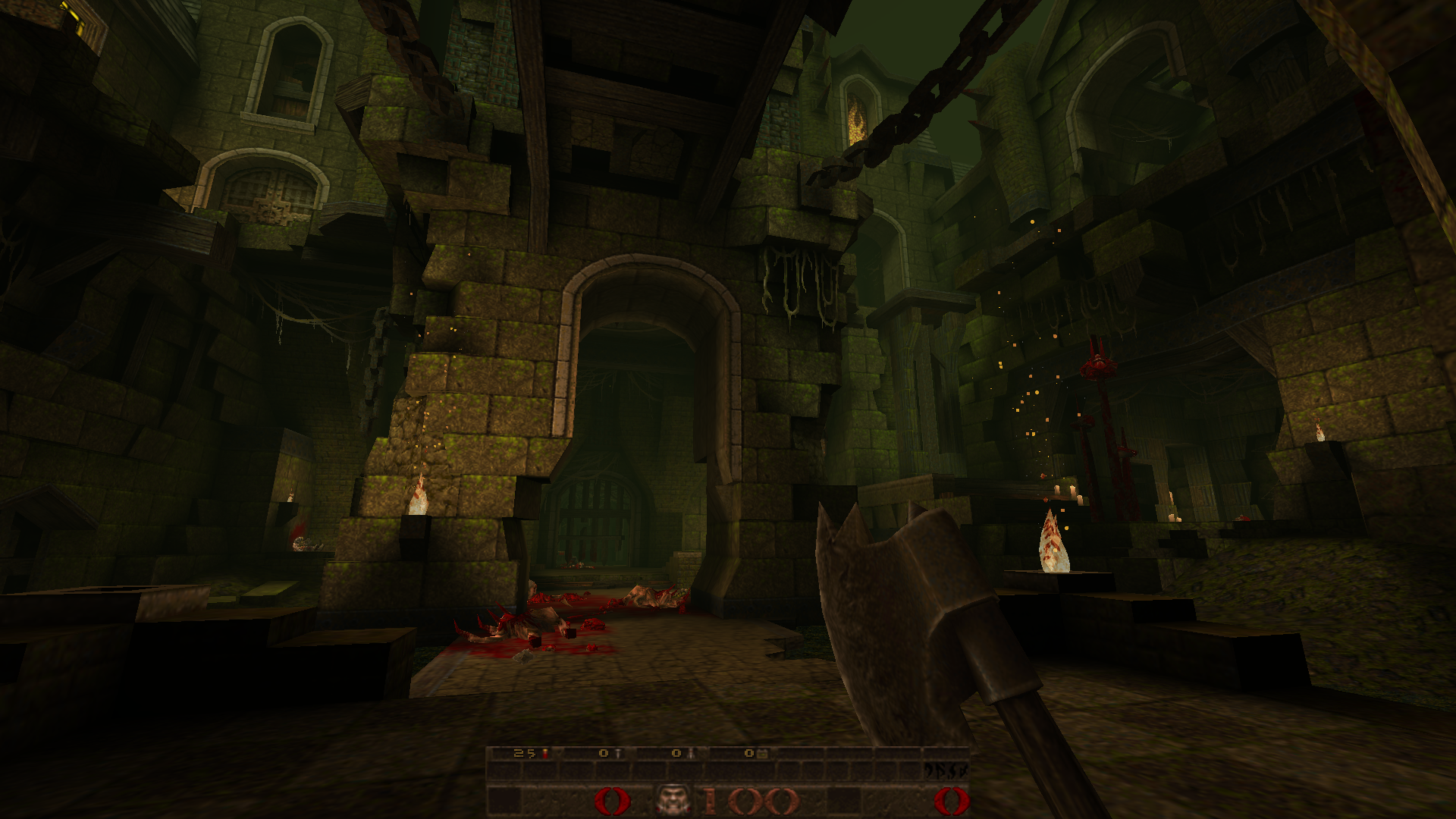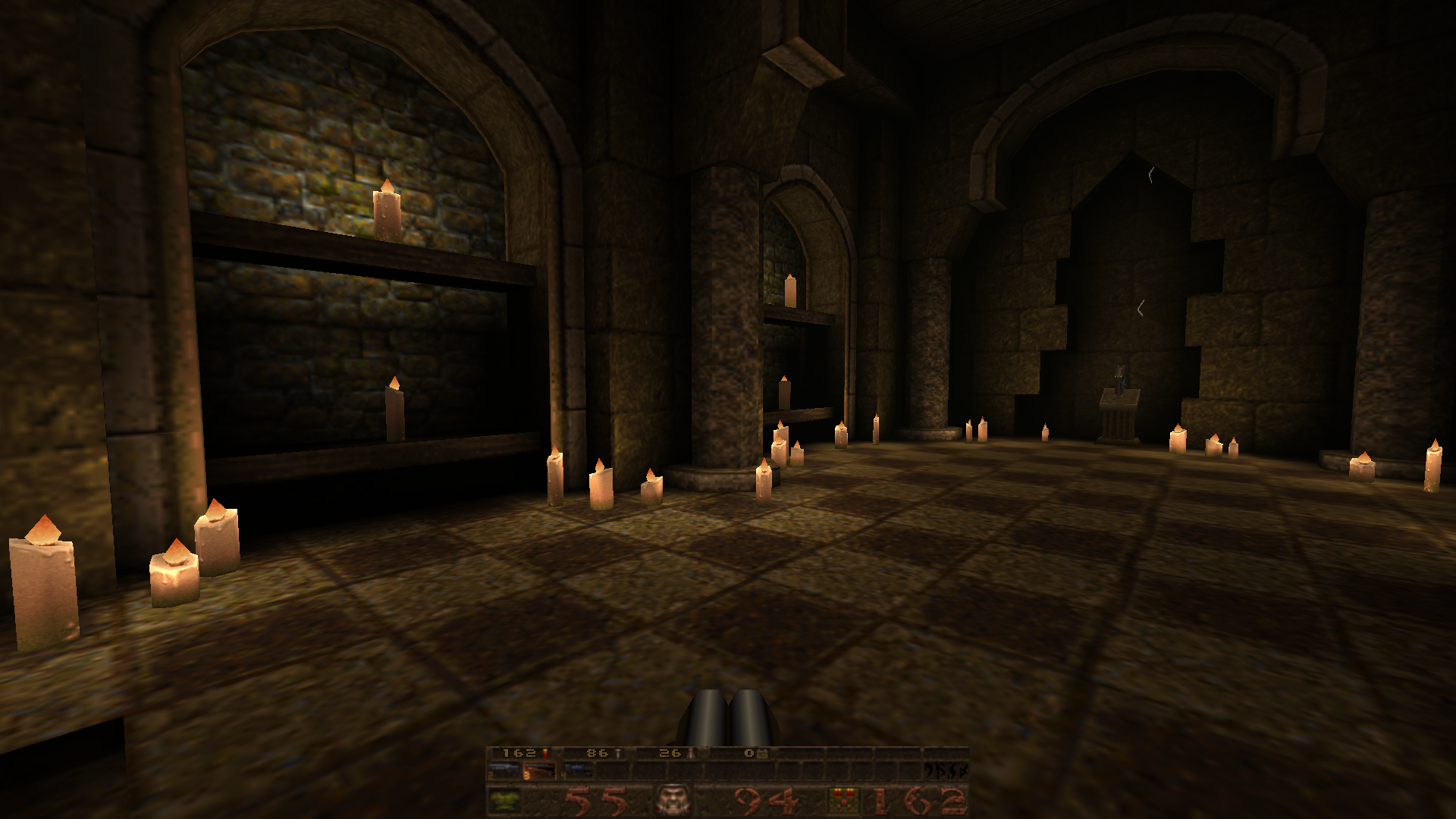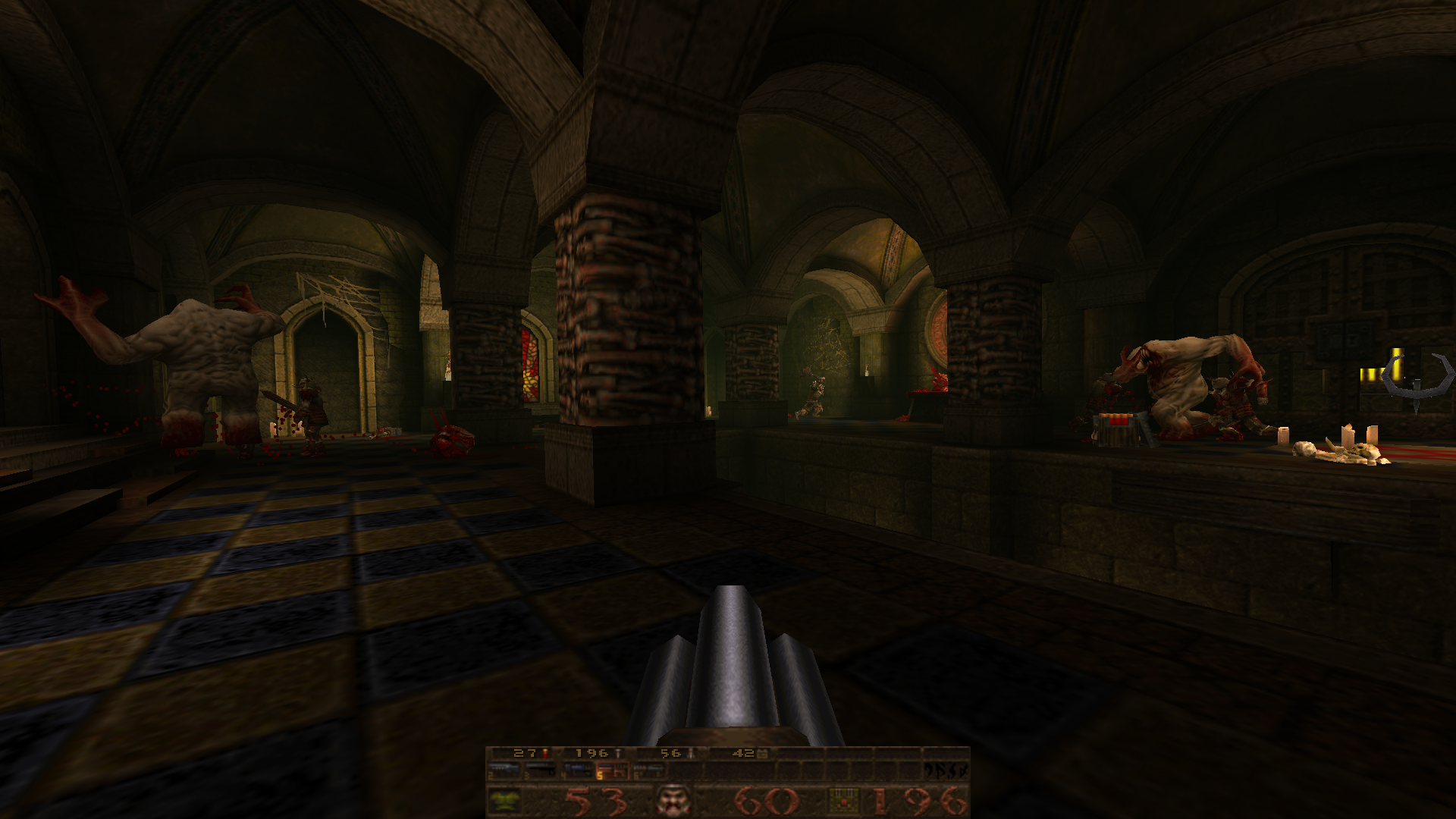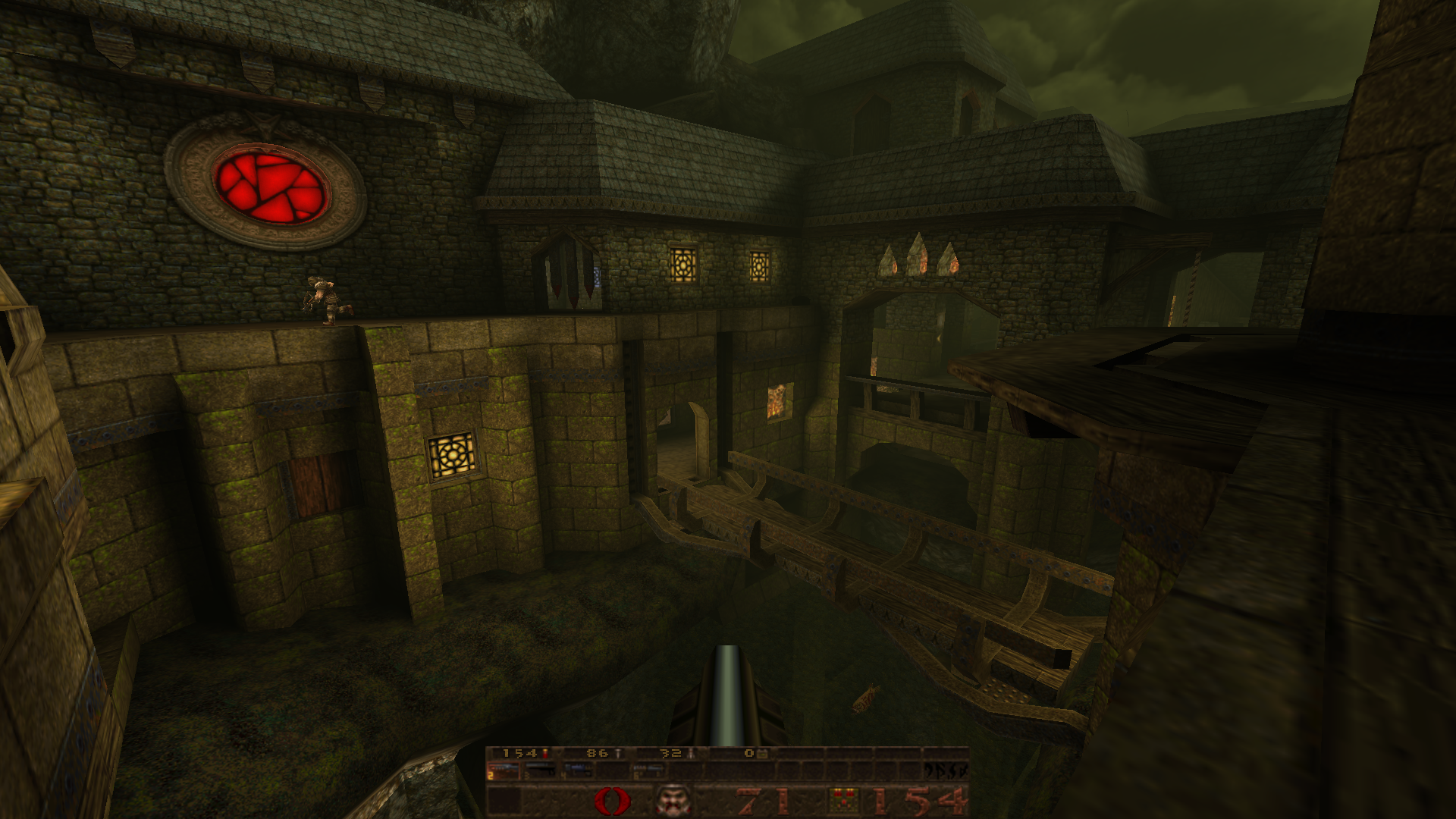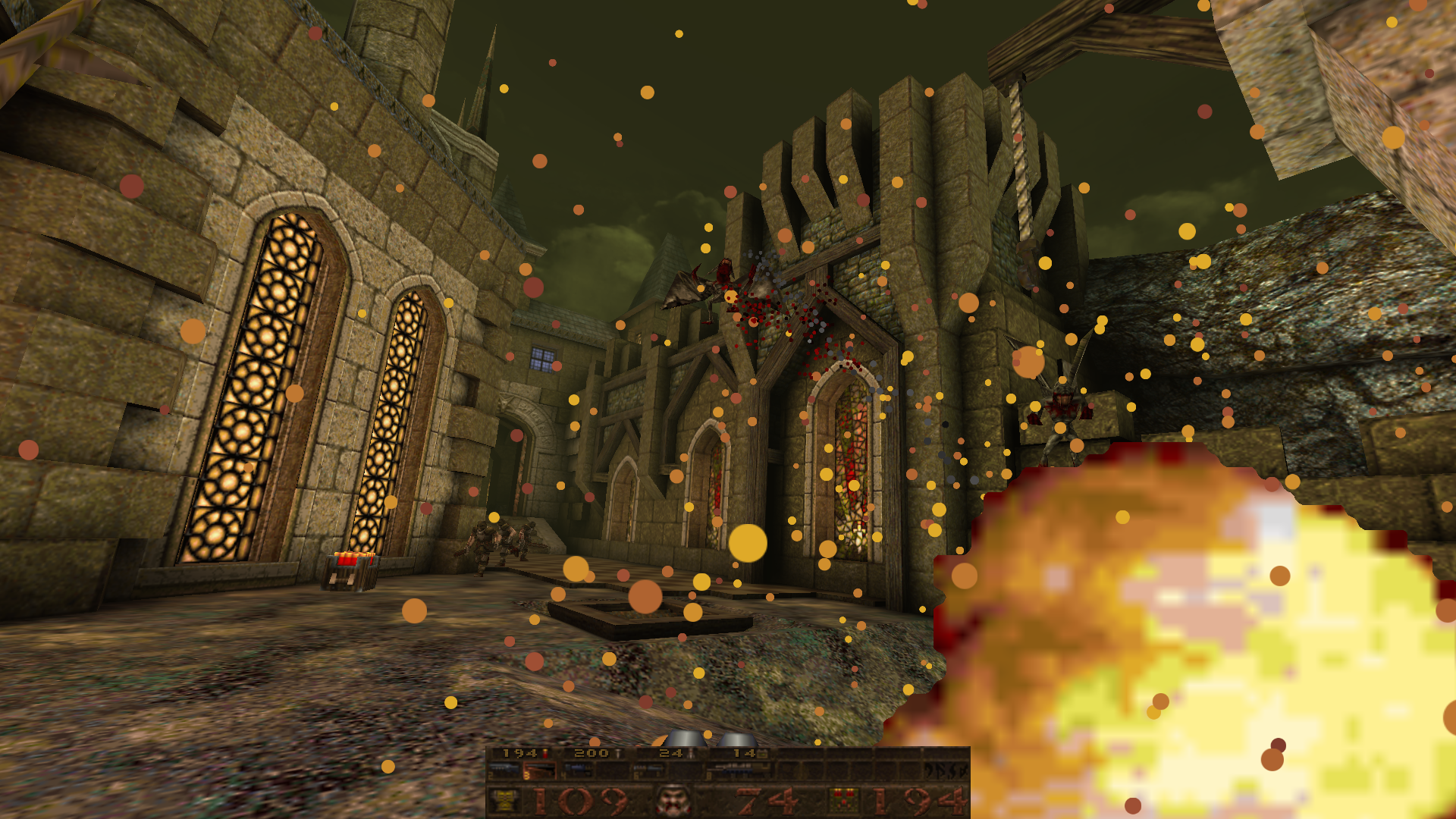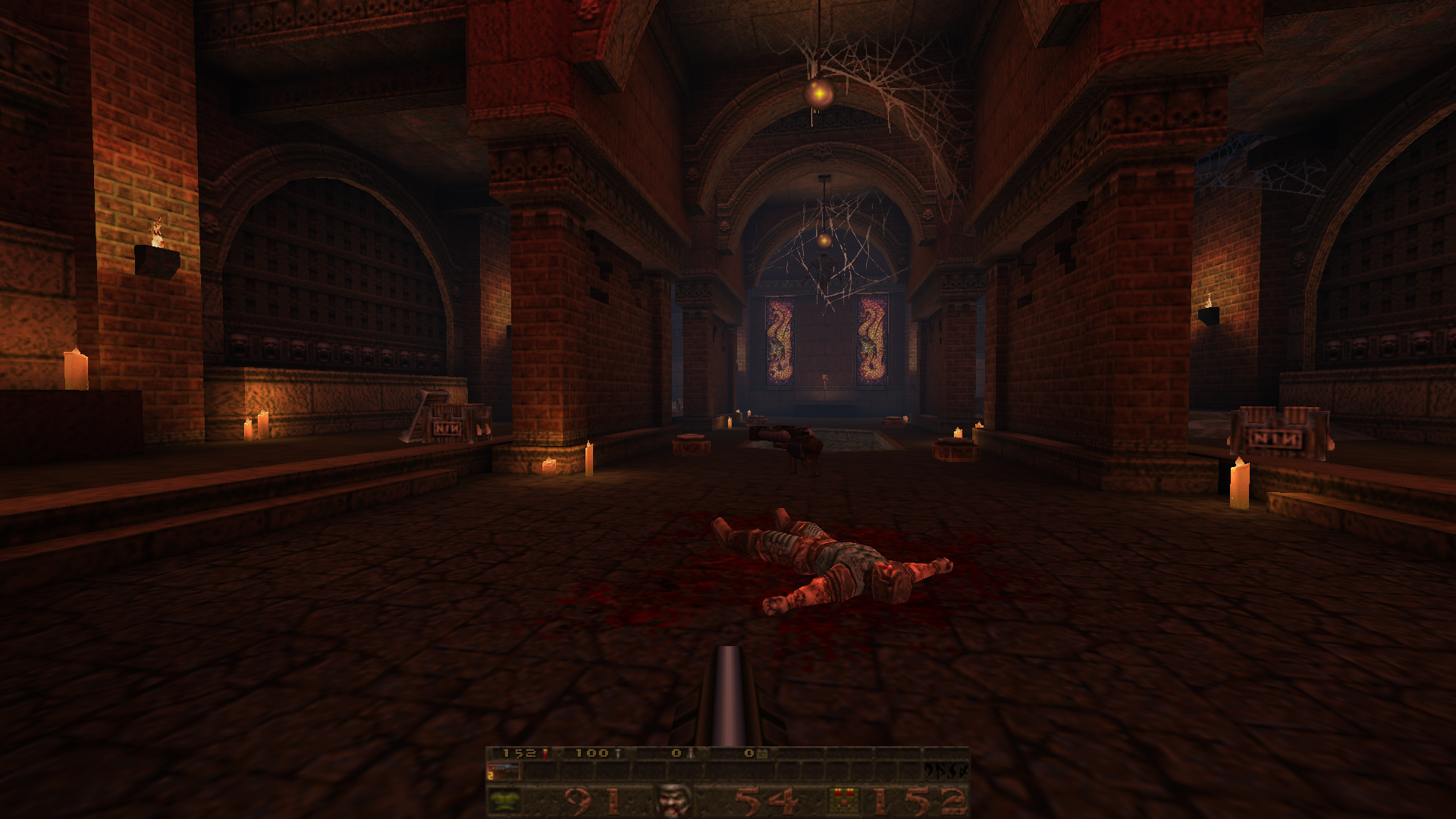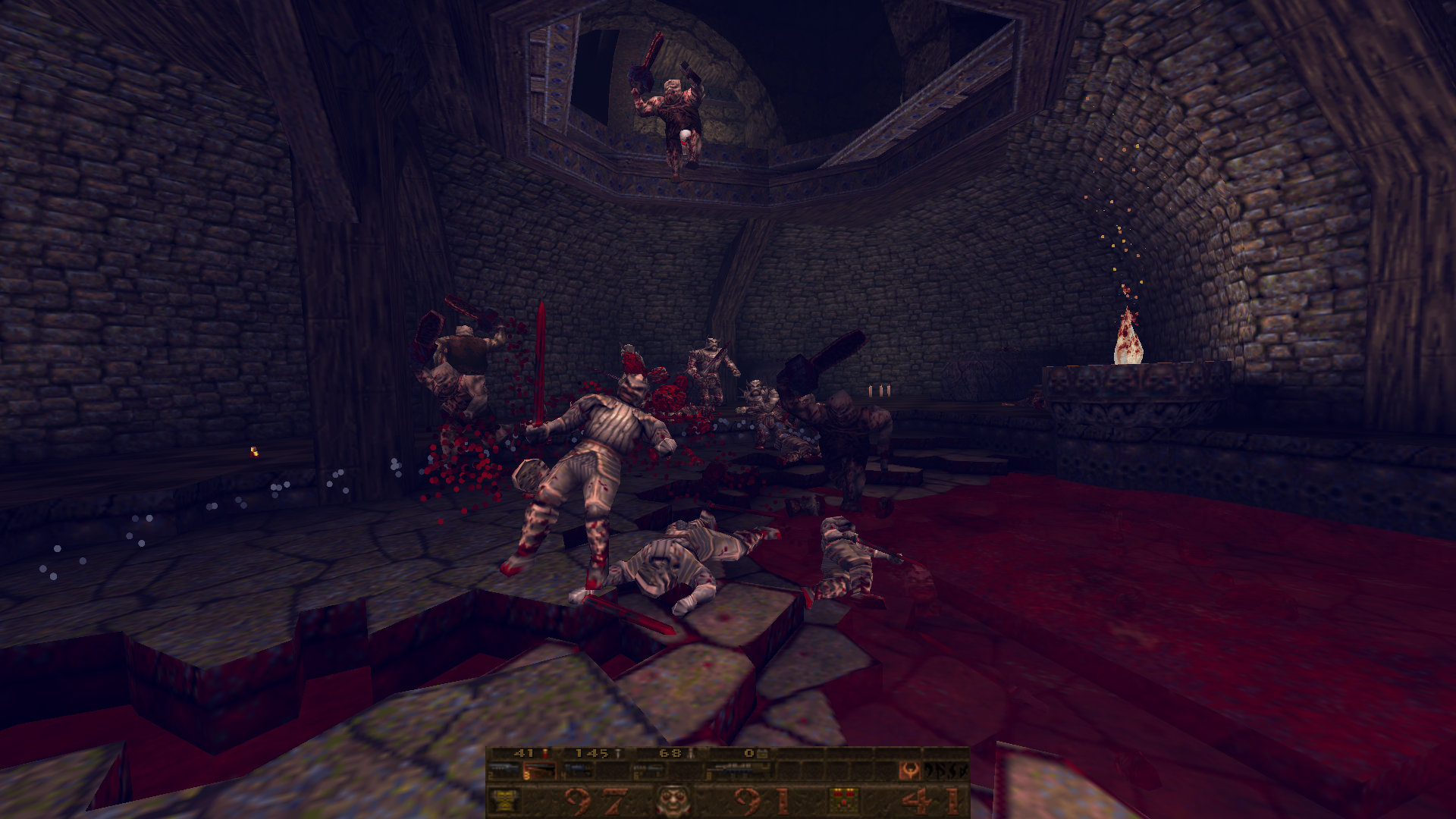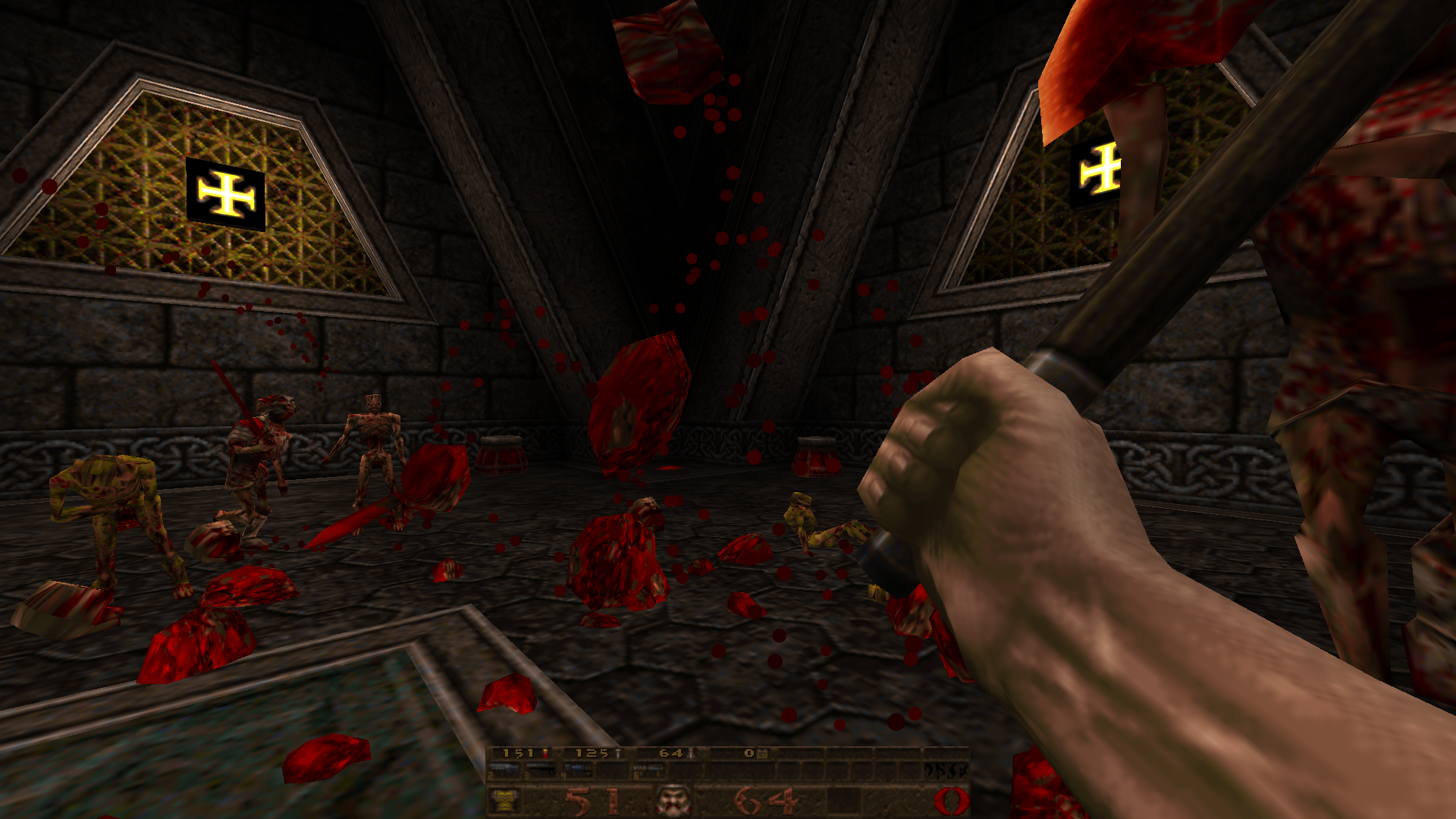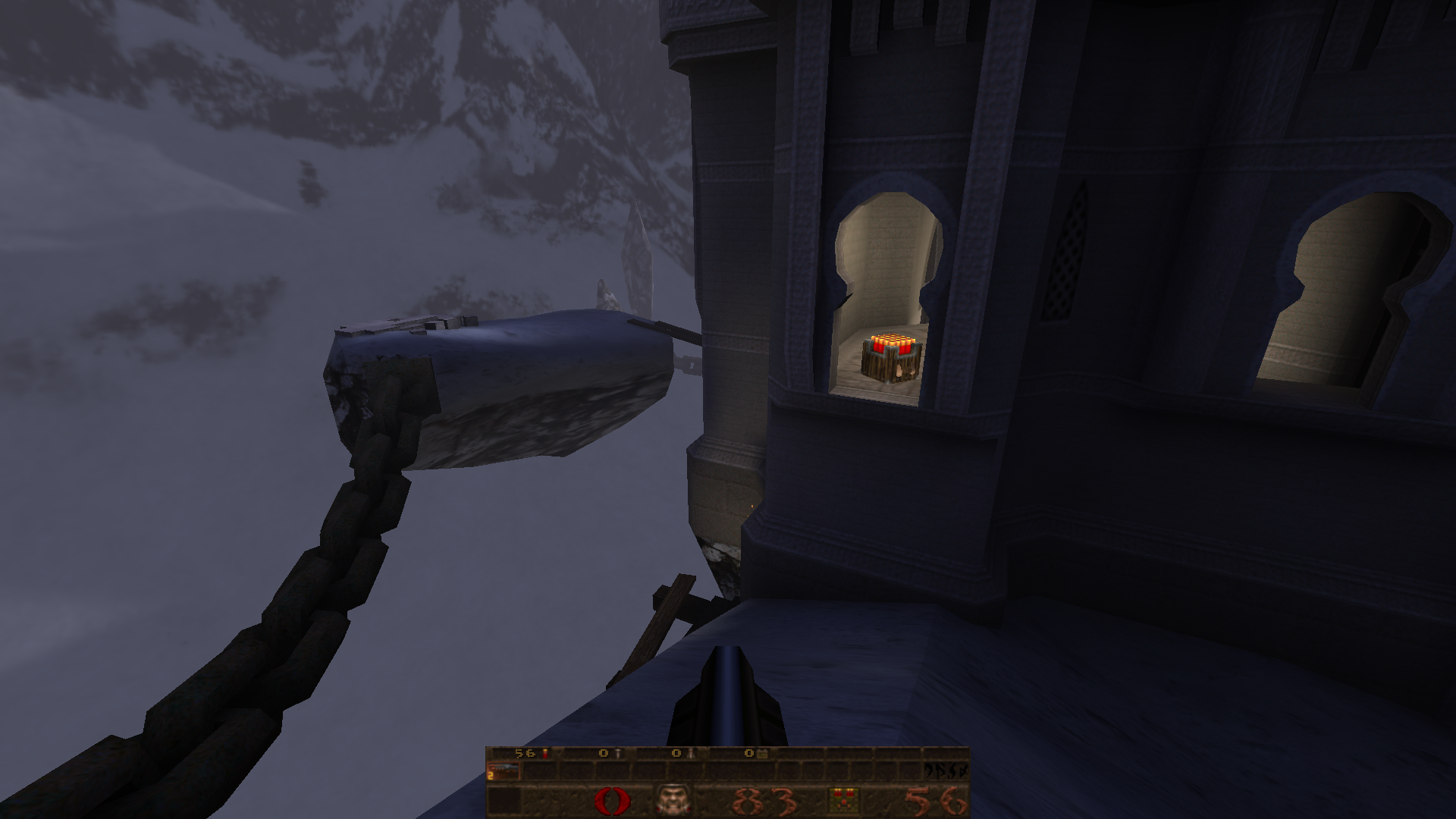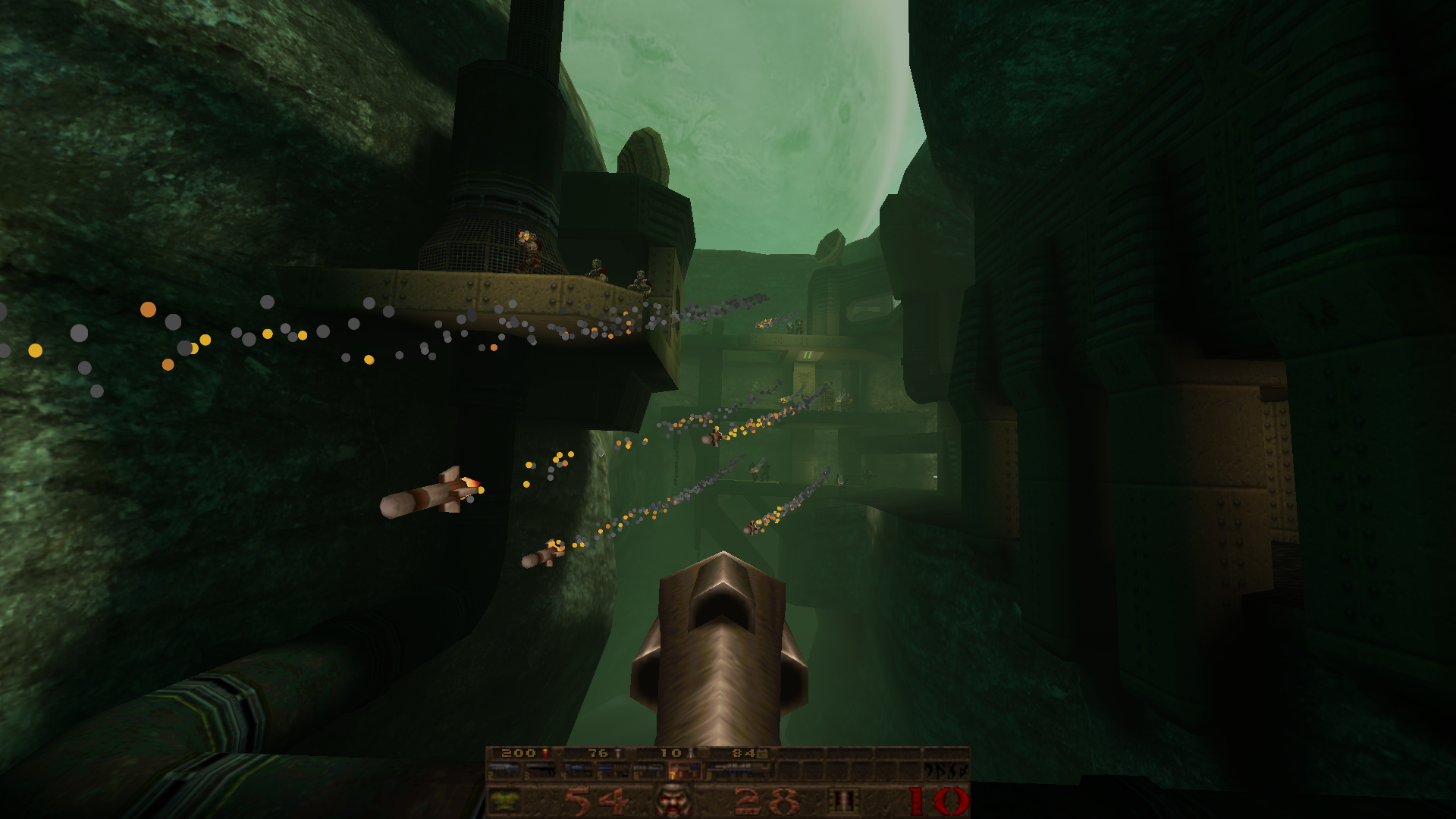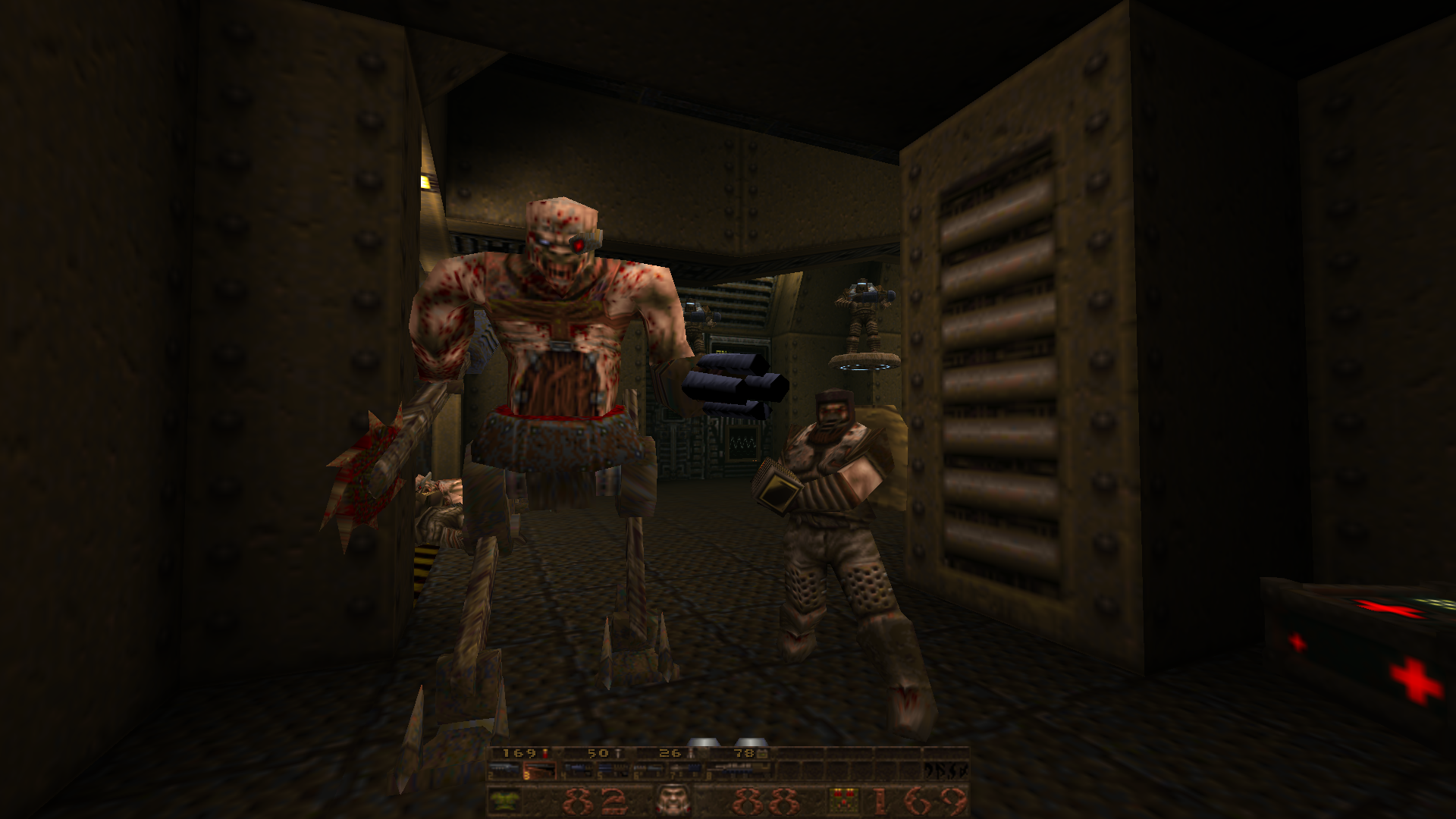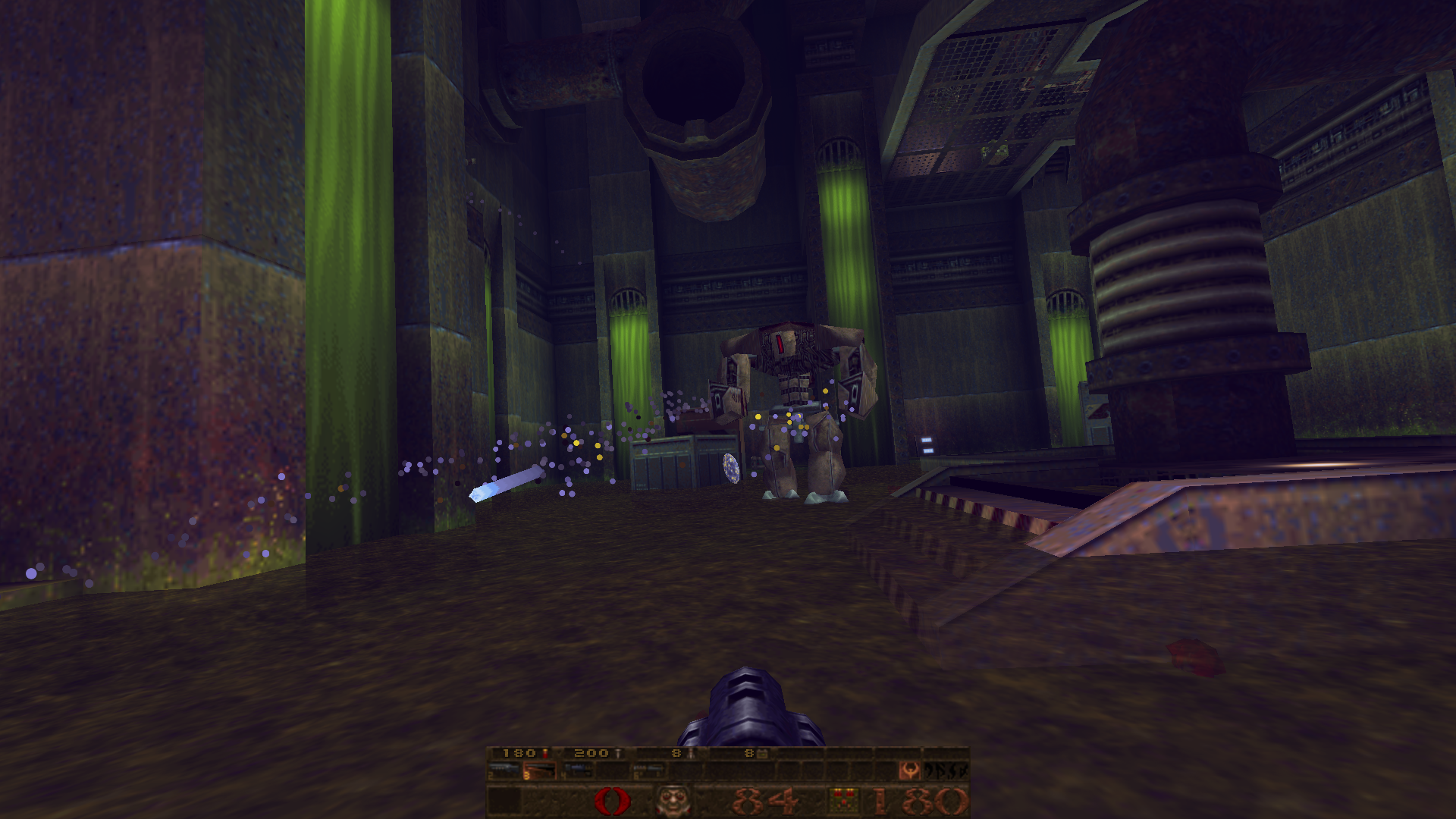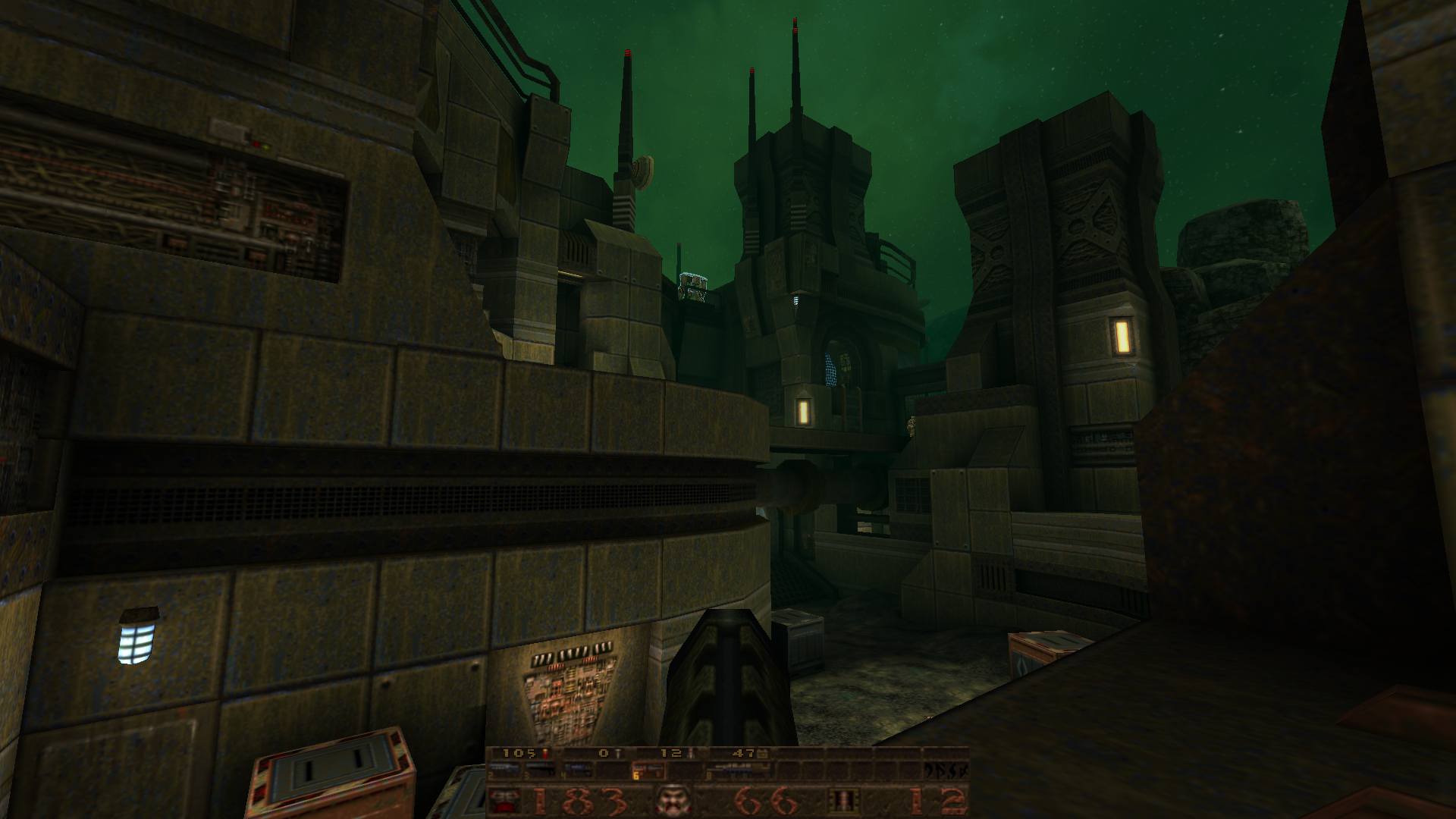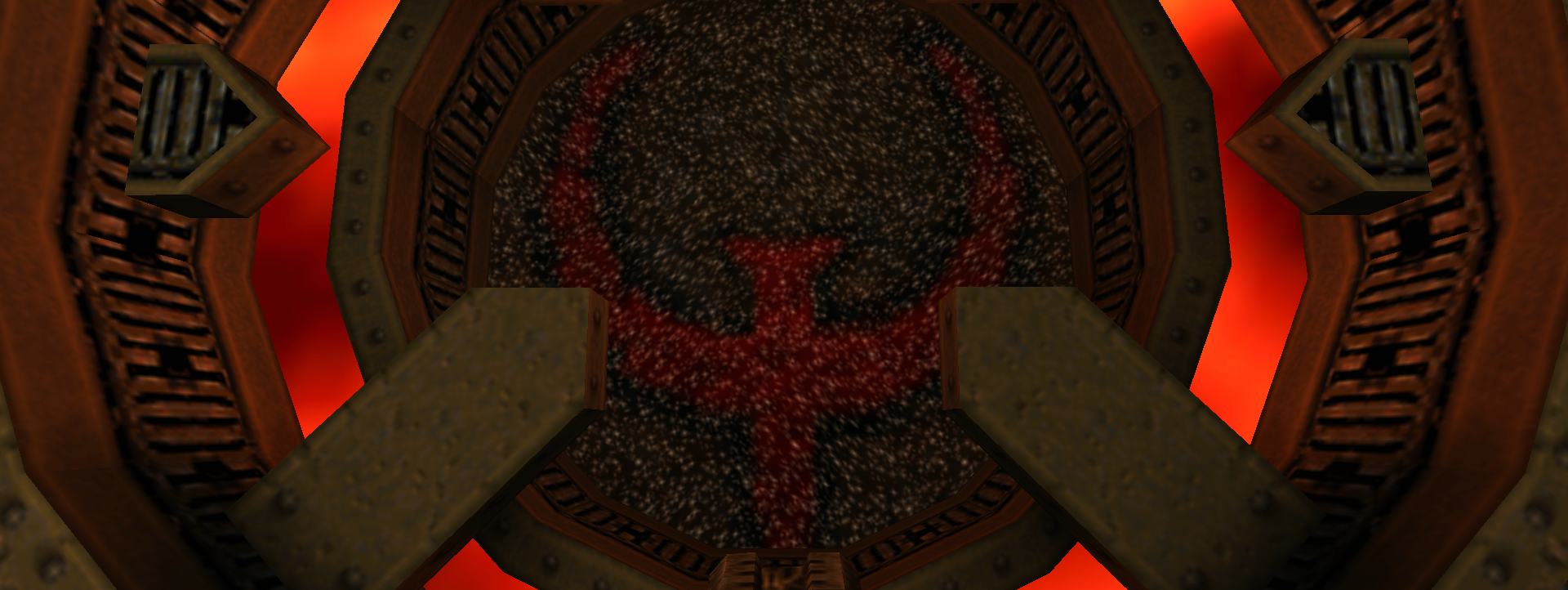
Many of my favorite Doom WADs — STRAIN, Scythe, Apostasy on Amalthea — are a bit of a mess. They’re works of undeniable (if undisciplined) genius, yet full of strange creative choices and huge fluctuations in quality. The mod we’re about to talk about may not be a Doom WAD, but it follows in that proud tradition just the same. It’s a profound, landmark achievement for its respective modding scene… but at the same time, the edges could have used a good amount more sanding.
I’ve wanted to get into Quake mods for a long, long time… but moving into a new mod scene is always a daunting prospect. I suppose I needed sufficient rekindling of my love for Quake first, and something to give me a real hunger for new content. Oddly enough, the thing that finally gave me that push was a Doom WAD… called Dimension of the Boomed.
The moment the credits rolled on Boomed, I knew exactly what I’d be playing next:

It’s been hard to exist on my corner of the internet for the last couple years without seeing mention of Arcane Dimensions absolutely everywhere. It’s one of the most impressive projects in 22 years of Quake modding, bringing together a team of high-profile mappers led by Simon O’Callaghan, and marries heaps of new monsters, weapons, texture sets, plus introducing new AI systems and destructible objects to the engine.
Unlike what I’ve come to expect from Doom WADs, though, there’s little in the way of a through-line here. All these maps are made by different people, with no real thematic thread to tie them together, and — most obviously — there’s no intended order for them to be played in. You can trace this decision back to the source material: Quake may have had numbered episodes, but you were free to ignore those numbers and jump in wherever you chose. Though, at least, those were episodes, and so no matter which you played first, there was a growing sense of scope and challenge from the first map to the last. Arcane Dimensions, to either its benefit or detriment, gives the player the freedom to create their own path through its many maps.
In my opinion it’s more of a detriment than benefit, and that’s because of how bloated Arcane Dimensions is with unnecessary and out-of-place maps. Sure, you can safely ignore the “test” maps, which are exiled away in a secondary hub area. It’s harder to write off the four “remix” maps, though, since those are accessed from the main hub just like the rest of the core maps — but they probably should be ignored, given that they’re all pretty uninspired remakes of classic Quake and Doom maps and don’t jive at all with the more grandiose new maps.
As far those core maps go, there’s seven included with the original Arcane Dimensions release and eight more added in the current patch. These are almost universally fantastic, though it’s regrettable that the ones that were patched in later are all relegated to their own separate hub. It makes them feel like they were tacked on as an afterthought — despite the reality that they’re just as good as the originals.
Your initial feelings on Arcane Dimensions will be entirely up to which order you play its maps. I played it in what was maybe the perfect order to give the absolute worst impression of the mod. Among the first three maps I played were two of the “remix” maps (this was before I realized the lower level of the hub was all remixes), which were in almost every conceivable way worse than the id maps they were remaking. At least those were short; but I played them sandwiched around Arcane Dimensions’ longest and most confusing map — and you probably know by now how much I hate long and confusing.
The experience improved drastically from there on out, though almost all of Arcane Dimensions’ maps are quite lengthy, and way more involved than Quake’s base maps. If you’re at all like me and prefer concise, tighter design, you’ll have to make the adjustment to the longer-form maps on offer here — but I think it’s worth making that adjustment.
You can ease into the swing of things with maps like Place of Many Deaths or Arcane Monstrosity, both of which demonstrate a lot more restraint in scale and monster count than their sibling maps. Monstrosity may in fact be my favorite outing in the entire mapset, from its skybound setting to the charming, chunky, cube-based architecture. This map knows exactly what it wants to be, and executes it perfectly, carrying you around and around and up and up these boxy structures connected by light bridges. One of the most compelling affordances of Quake mapping over Doom mapping is the ability to create playable spaces directly above other playable spaces, and that’s on display in spades here. It’s beautiful, genius stuff and I highly recommend starting here if you’re giving Arcane Dimensions a shot.
If we’re talking focused design, Firetop Mountain also comes to mind with its stunning, gloomy volcano temple. The action is relentless and unforgiving as you delve deeper into the titular mountain, and out of all Arcane Dimensions’ maps, this feels the most like pure, classic Quake. Plus we get the triumphant return of the Chthon boss, and an awesome series of secrets that involve following the ghost of a knight who came before you.
As far as the lengthier maps go, my favorite by far is Leptis Magna. It may run on for longer than it needs to, and go on a couple unnecessary detours, but the whole thing is delightfully paced and has such an interesting thematic element. Leptis Magna, you see, is an ancient city of Shug-Niggurath’s minions — much more civilized than anything we ever saw in Quake. The whole city is watched over by the statues made by a creature called The Sculptor. You begin in the streets and courtyards, then graduate to raised pathways between towers and stairwells, and finally reach the ramparts and turrets at the top of it all. Ogres and knights can be expected around every corner, but the map also fittingly introduces living statues, a wizard enemy type, minotaurs, tons of variants on ogres and vores, not to mention the Sculptor boss itself.
Which brings us to Arcane Dimensions’ biggest bugbear, unfortunately. A lot of modders, myself included, struggle when adding new monsters to an established bestiary. I try to come at it with the philosophy that the point of adding enemies is to add something of substance; to fill a niche that wasn’t filled before; to put new some spin on gameplay; to do something different, and thus make the game richer. That is not the philosophy behind Arcane Dimensions’ additional enemies, which could still be fine in moderation… but there are utter shitloads of new baddies crammed into this mod. It may not sound like a bad thing at first, but let me try to illustrate the problem.
In Quake, you’ve got ogres, scrags, vores, deathknights, shamblers — each with their own function and their own appearance. If you were to enter a room with one of each of those enemies in it, you’d know in an instant what enemies you’re facing, what sort of threat each one poses, and which to prioritize. Elegant, beautiful simplicity.
In Arcane Dimensions, there’s an ogre with a chainsaw, an ogre with a hammer, and an ogre with a mace. There’s a tan vore and a purple vore. There’s a deathknight with a sword, a deathknight with a flail, a deathknight with two swords, and a deathknight with one sword but who’s covered in extra blood. I’ve played through the whole mod and I’m still not 100% clear on the difference between all of these. And there’s a hundred more variations I haven’t even mentioned, like the three different skins for the regular knight that I’m 95% confident are all functionally the same. Or the 27 different armor colors on grunts and enforcers, each of which indicates they’re carrying a different weapon. Or the goomba-headed soldier with the same behavior as the knight but half the HP (of what was already a very low HP count).
For every enemy that adds something of substance (like the crossbow soldier — a much-needed low-threat projectile enemy), there’s half a dozen functionally useless variations. You get a cool wizard who spawns flying skulls (awesome!) but also a recolor of that same wizard who just throws projectiles like three dozen other enemies. Or you get two enemies that fill the exact same niche: miniature vore-spawns that run around and jump at you… and also spiders of the same size that run around and jump at you. It’s variety in the most meaningless sense.
The effect is a muddying of the waters — a loss of Quake’s visual language. Where you had a small number of functionally- and visually-distinct opponents before, and you could judge a situation at a glance, now you can barely tell anything apart and have no idea exactly what you’re up against. It’s chaos: messy, busy, ugly chaos.
Don’t get me wrong. I appreciate the statue enemies in Leptis Magna for example, even though two out of three of them are just reskins of other enemies, and that’s because they serve a thematic purpose. In other maps, the statues are just haphazardly mixed in with regular enemies for no reason I can fathom. All the color-coded human enemies also make some amount of sense, given how slim your pickings normally are on techbase maps. And I’ll admit I have a big soft spot for the cyborg ogres you’ll see in a couple maps, or the big-ass robots that sadly only show up in Terror Fuma. But one of the most interesting additions is this flying drone that actively dodges your attacks, forcing you to really pay attention and either spray like crazy or get up close so they don’t have room to dodge.
I don’t think it’s unrelated that the tech maps are often where Arcane Dimensions shines brightest. I already covered Arcane Monstrosity, but Crucial Error and Terror Fuma are fantastic as well. The latter is an interesting anomaly in the mod: a considerably more cinematic map than any of the others. It begins with a mysterious ship flying overhead and landing on top of the facility. A moment later, extra-dimensional bugs are warping in from who knows where, and throughout the map you stumble upon security forces trying to fend off the invading creatures in very Half-Life-inspired tangles — and then it’s your job to mop up whichever side won.
I should probably talk in more detail about the “longest and most confusing map” I mentioned early on, and that’s The Forgotten Sepulcher (or just “The Forgotten” as it’s called on the hub level). Sepulcher has gotten a ton of attention since its release — way more than any other map in the set. It’s been called the “most ambitious Quake map ever built,” and is definitely the most involved, sprawling level you’ll find in Arcane Dimensions. And it’s good. But it’s also often unclear where it wants you to go, and it’s so over-detailed and samey that you never know where you are.
Still, Arcane Dimension’s greatest strength is how different each map is from its neighbors. There is something here to please almost every player, and even if you don’t care for a certain map, you’ll probably enjoy most of the others. Maps like The Forgotten Sepulcher, Foggy Bogbottom, and Obsessive Brick Disorder didn’t do much for me, but I was enraptured by Arcane Monstrosity, Firetop Mountain, and Leptis Magna — just to name a few.
At the mod’s lowest points I was… maybe a little lost or frustrated. At its highest points, I was ten years old again. I was playing Quake for the very first time. I was in love with dark, nightmarish, alien worlds. I felt the impossible joy of a child.

I don’t doubt that Arcane Dimensions could have benefited from a touch of restraint in some places. Its designers could have used someone reigning in their worst instincts to fill the mod past the point of bursting. But it’s still the case here just as it is with all my favorite things: I’ll take extravagant-and-unpolished over restrained-and-unspectacular any day of the week.
You can find Arcane Dimensions on Simon O’Callaghan’s website. And if you’re interested in Doom WADs, be sure to check these out!
